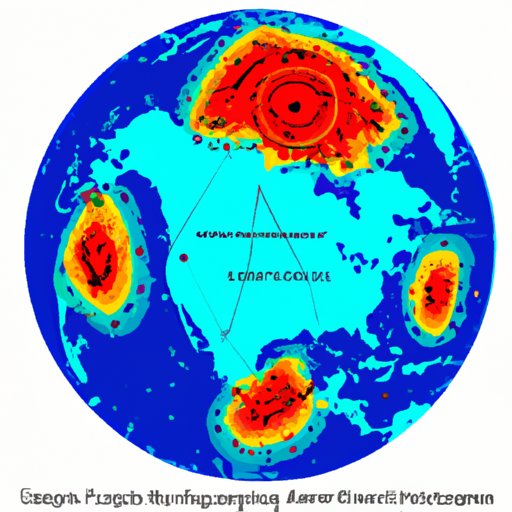Introduction
Volcanoes are a fascinating natural phenomenon, offering both spectacular views and a unique insight into the inner workings of our planet. But where exactly are the most volcanoes located? This article provides an informative overview of the world’s most volcanically active regions, and offers an in-depth look at the locations, causes, and effects of major volcanic zones.
Comprehensive Guide to the Most Volcanically Active Regions of the World
When it comes to volcanoes, there are three main areas that stand out as particularly active: the Ring of Fire, hotspots, and major volcanic zones. Let’s take a closer look at each of these areas in turn.
Ring of Fire
The Ring of Fire is an arc of intense volcanic and seismic activity that stretches around the edges of the Pacific Ocean. It is home to some 75% of the world’s active and dormant volcanoes, making it one of the most volcanically active regions on Earth. The Ring of Fire is also responsible for producing some of the world’s largest earthquakes, with the 2011 Tōhoku earthquake and tsunami being the most recent example.
Hotspots
Hotspots are localized areas of intense volcanic activity. They are usually associated with mantle plumes, which are columns of hot material rising from deep within the Earth’s interior. Two of the most active hotspots in the world are located in Hawaii and Indonesia.
Major Volcanic Zones
In addition to the Ring of Fire and hotspots, there are several other major volcanic zones located around the world. These include the Cascade Range in the western United States, the Andes in South America, the East African Rift Valley, and the Kamchatka Peninsula in Russia.

Exploring the Ring of Fire
The Ring of Fire is home to some of the world’s most active volcanoes, including Mount St. Helens in the United States, Mount Fuji in Japan, and Mount Pinatubo in the Philippines. The highest concentrations of volcanoes can be found along the western coasts of North and South America, as well as the islands of the Pacific Ocean. Other volcanoes in the Ring of Fire region include Kilauea in Hawaii and Sakurajima in Japan.
Mapping the Earth’s Most Volcanic Hotspots
Hawaii is one of the most volcanically active regions on Earth, with five major volcanoes, including Mauna Loa, Kilauea, Hualalai, Loihi, and Haleakala. All of these volcanoes are active, and they are responsible for much of the island’s dramatic landscape. Indonesia is another hotspot of volcanic activity, with over 100 volcanoes spread across the country. The most active of these is Mount Merapi, which last erupted in 2010.
From Hawaii to Indonesia: A Look at the World’s Major Volcanic Zones
The Pacific Rim is the most prominent volcanic zone in the world, stretching from Alaska in the north to Peru in the south. Within this zone, there are several subzones, including the Aleutian Islands, the Cascade Range, the Andes, and the Hawaiian Islands. In addition to the Pacific Rim, there are several other major volcanic zones located around the globe, including the East African Rift Valley, the Kamchatka Peninsula, and the Mediterranean.

The Pacific Rim and Beyond: Examining the Global Distribution of Volcanoes
Volcanoes can be found in every continent except Antarctica. The Americas are home to some of the world’s most active volcanoes, including Mount St. Helens in the United States, Popocatépetl in Mexico, and Cotopaxi in Ecuador. Meanwhile, Europe is home to some of the world’s most famous volcanoes, such as Vesuvius in Italy and Eyjafjallajökull in Iceland. The causes and effects of volcanic eruptions vary from region to region, but they all have the potential to cause serious destruction.
Conclusion
This article has provided an overview of the world’s most volcanically active regions, exploring both the Ring of Fire and the major volcanic hotspots. We have seen that the highest concentrations of volcanoes are located along the Pacific Rim, and that volcanoes can be found in every continent except Antarctica. Finally, we have discussed the causes and effects of volcanic eruptions, and their potential to cause serious destruction. From the Ring of Fire to the Pacific Rim and beyond, this comprehensive guide offers an invaluable insight into the locations, causes, and effects of the world’s most volcanically active regions.


